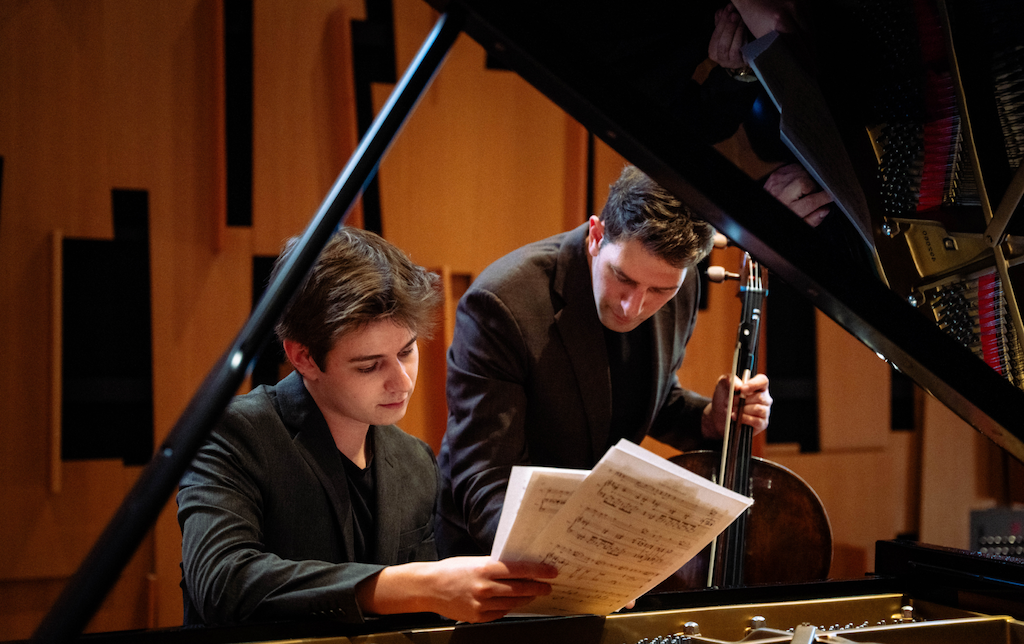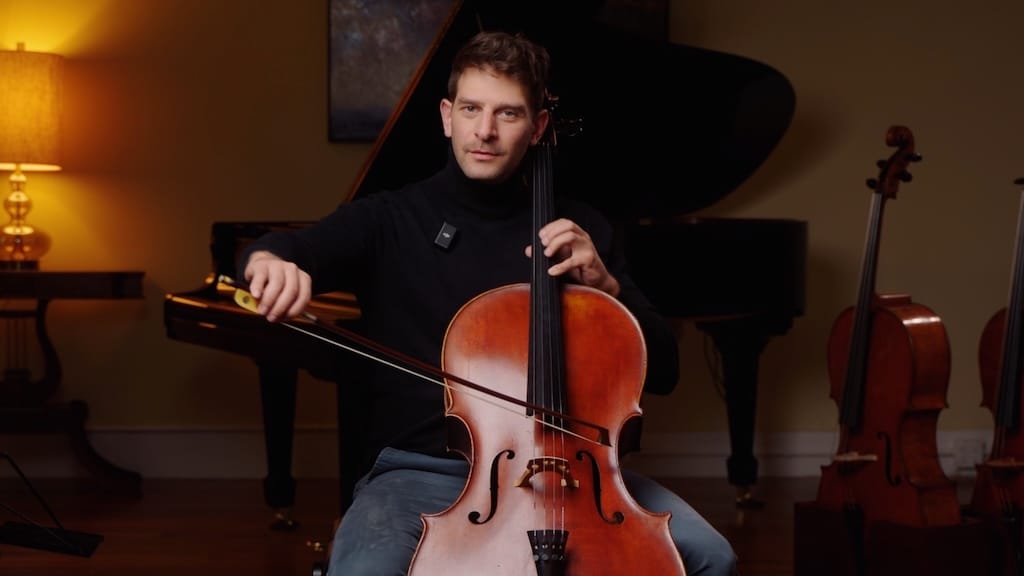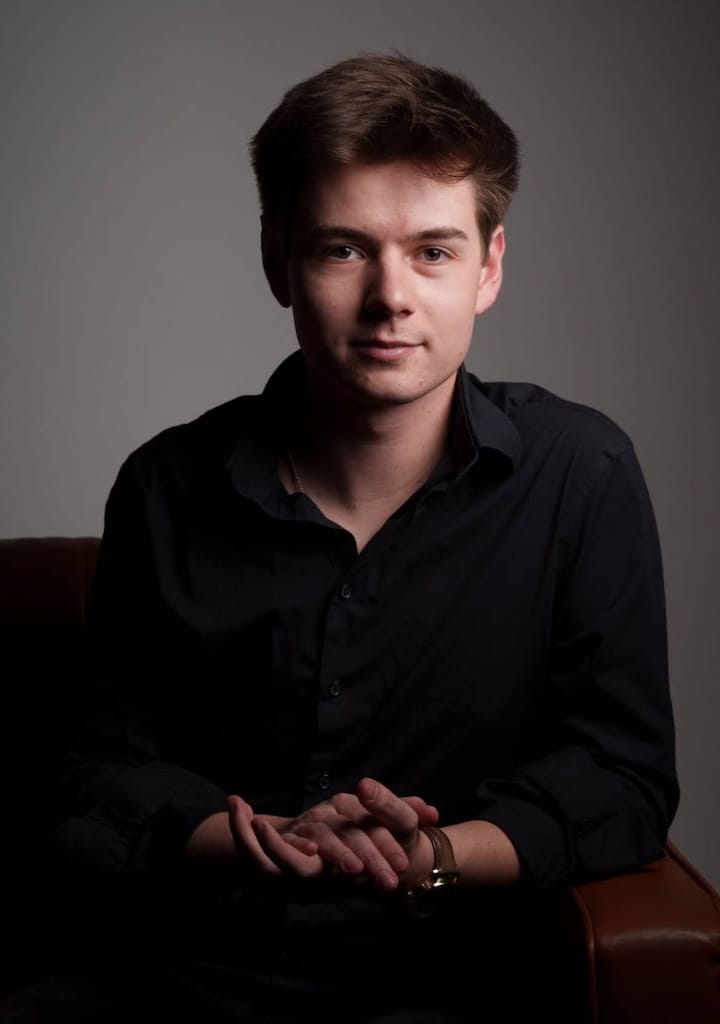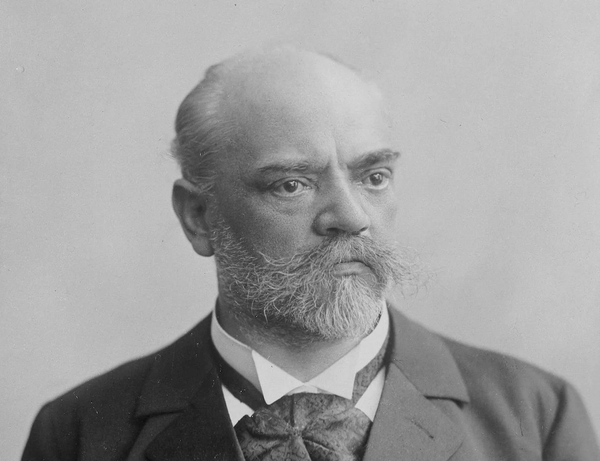Aidan Vass and Daniel Lelchuk Release 'Cello Sonata'
Aidan Vass and Daniel Lelchuk discuss ‘Cello Sonata’, their cross-country collaboration that channels the natural world’s beauty through music: a lyrical, exploratory work uniting compositional precision with spontaneous emotional dialogue.

Released on 26 September 2025, Cello Sonata unites the artistry of cellist Daniel Lelchuk and pianist-composer Aidan Vass in a recording that explores the dialogue between human emotion and the natural world.
Recorded in Los Angeles after months of cross-country collaboration, the work unfolds as an evolving soundscape, from the quiet emergence of its chromatic opening motif to sweeping, organic gestures that mirror the structures and asymmetries of nature itself. At once lyrical and textural, Cello Sonata reflects the duo’s shared fascination with the balance between intuitive musical language and the elemental beauty of natural form.

Daniel Lelchuk, described by The Washington Post as a “dazzling virtuoso,” is a cellist of rare versatility, assistant principal of the Louisiana Philharmonic, a frequent performer at leading venues and festivals from Salzburg to Muscat, and an acclaimed pedagogue known for his work with tonebase.
Aidan Vass (b. 2003) is an American composer and pianist whose music has been performed by ensembles including the LA Philharmonic, UCLA Philharmonia, and Nu Deco Ensemble. A graduate of the UCLA Herb Alpert School of Music and a former LA Phil Composer Fellow, Vass’s work is noted for its structural clarity and emotional immediacy, uniting modern expressiveness with a deep sensitivity to texture and gesture.

In Cello Sonata, Lelchuk and Vass seek to embody the intrinsic harmony of nature’s forms, the way one shape or gesture gives rise inevitably to another. The sonata opens and closes with the same chromatic fragment, creating a sense of cyclical unity while allowing the music to expand, transform, and ultimately return to its origin. The result is a profoundly human reflection on sound, structure, and shared musical intuition.
In the following interview, Aidan Vass and Daniel Lelchuk discuss the creation of Cello Sonata, from the challenges of collaborating across distance to the artistic dialogue between composer and performer. They reflect on the work’s organic inspiration, the pressures of the recording studio, and the unique chemistry that emerges when two musicians shape a piece together from its very first note to its final resonance.
Serenade Team: ‘Cello Sonata’ was born out of a cross-country collaboration. How did the two of you navigate distance and maintain a shared creative vision throughout the process?
Aidan Vass: I think the fact that we had two distinct roles during this process helped us manage the distance. I was able to start off by leading the collaboration because, without the piece being completed to some degree, there was no real collaborative element. Once I had at least a mostly final draft of the work, Daniel had time to work on his part independently. But I think the magic happened during what was really only one day when we met up in LA, rehearsed, and recorded the entire piece. That timing was quite stressful but also exhilarating. It forced us to really concentrate on our collaborative performance of the work while also workshopping elements of the piece.
Daniel Lelchuk: For me, the most important part of this process was respecting the composer’s vision. My job as a performer is to bring the music to life. Even though the composer and I know each other and spoke on and off throughout the process, I feel that no matter what music I’m playing, whether it’s Beethoven or a world première, I must treat it with the utmost respect, even reverence. This is part of being a real professional. So, I took a rather passive approach during the creation of this piece because I felt the composer deserved space and time to create the work he envisioned.
ST: The piece draws inspiration from natural forms and gestures. Could you elaborate on how the structures of the natural world informed your musical language?
AV: The piece’s derivation from forms and gestures in nature is more abstract than literal, it’s really a comment on my audiation process while composing. I find a lot of inspiration in natural structures like mountains, river deltas, and trees, particularly the quality of having components or shapes that feel “naturally” intuitive and exploratory.
Think about a river delta: it doesn’t follow a precise sense of symmetry or formal balance, but it appears organically unified: cohesive, unbalanced, yet fundamentally beautiful. When composing this piece, I tried to audiate gestures between the piano and cello that were derived from this sense of coherent gesture, like a mountain ridge or tree branch, yet felt fundamentally connected to one another in the same exploratory way. Just as one distributary branches off another in a “necessary” way, I aimed for each gesture between the piano and cello to feel like the inevitable conclusion of the previous one. For this reason, you’ll hear many shapes in both parts that feel like call and response, each deliberately, “sort of,” related to the other.
ST: Aidan, as both the composer and pianist, how did your dual role shape the way the piece evolved, particularly in dialogue with Daniel’s cello writing and interpretation?
AV: First off, I think being the pianist on this recording forced me to write realistic piano parts that weren’t asking too much of the player. But more seriously, I wanted to create a piece that really required the performers to listen to each other as much as they were reading the score. This quality made the composer and performer roles feel much more connected. Every note of the piece is clearly notated, as is most of the timing, but the music doesn’t really work unless both performers are listening closely to one another. That brought a sense of composition into the pianist’s role, and a sense of performance into the composer’s role.
ST: Daniel, what aspects of Aidan’s writing most spoke to you as a performer, and how did you approach shaping the sonata’s emotional and textural landscape on the cello?
DL: First of all, the piece is very well written for the instrument. A big part of writing effective music is understanding how individual instruments work from a physical point of view. If you don’t understand the mechanics of an instrument and you’re composing for it, you’re not really setting yourself up for success, to put it mildly. Aidan’s writing demonstrates real expertise and knowledge of the cello.
Beyond that, I was drawn to the melodic writing. The cello is, first and foremost, a singing instrument, and Aidan really utilised its lyrical and expressive capacities.
ST: The sonata opens and closes with the same chromatic fragment, creating a sense of cyclical unity. Was that structural idea present from the start, or did it emerge organically during development?
AV: This was actually one of the few rigid ideas I had at the very beginning. More than creating a sense of cyclical unity, which is absolutely relevant to the piece, I treated this small chromatic fragment as a kind of “cell” from which the entire work expanded. The contrast between this tiny musical idea (tiny in terms of space) and some of the grander, sweeping gestures of the piece created a strong developmental foundation to build from.
ST: The recording was made in Los Angeles after months of preparation. What was it like finally bringing the work to life in the studio, and did anything unexpected happen during the session?
AV: The first few hours of rehearsal were definitely high pressure from my end. It took some work to iron out the coordination between the parts, but the payoff was immensely rewarding. I found it a lot of fun to play through those high-coordination passages once everything clicked.
DL: The rehearsals and recording sessions were exhilarating. When the microphones are rolling, the pressure is on and there’s no time for senseless errors. You have to use rehearsal time efficiently, fix problems, and move on. At the same time, you don’t want to become overly clinical. Finding that balance is both the exciting and the challenging part!
ST: Collaboration between composer and performer can sometimes blur traditional roles. How did you both influence each other’s artistic choices through this process?
AV: Our roles, aside from my doubling as pianist, were relatively standard and straightforward in terms of the line between composer and performer. During our short rehearsal, I learned a lot from hearing Daniel shape the phrases in the music. There’s a level of humanity that becomes so apparent when a performer takes your work and truly makes it sing. That encounter inspired a few last-minute decisions to lean further into that singability.
DL: The composer rules! In all seriousness, playing with a composer who is also performing, in this case, Aidan at the piano, is a blessing. I learned so much about the piece and the soul of the music. It was a real honour.
ST: How do you hope listeners will experience Cello Sonata — as a narrative, a reflection of nature, or something more abstract and emotional?
AV: I think all three of those elements are intended equally. I hope listeners experience this work as an abstract narrative, one that draws them into the intuitive and exploratory relationship between Daniel and me.
DL: Every piece has a different story to tell, and every listener experiences music in their own meaningful way. This sonata has an intriguing emotional sweep that I’m sure will resonate with listeners for many years to come.
Cello Sonata by Aidan Vass and Daniel Lelchuk is now available on Tonsehen. Listen to the album here.





